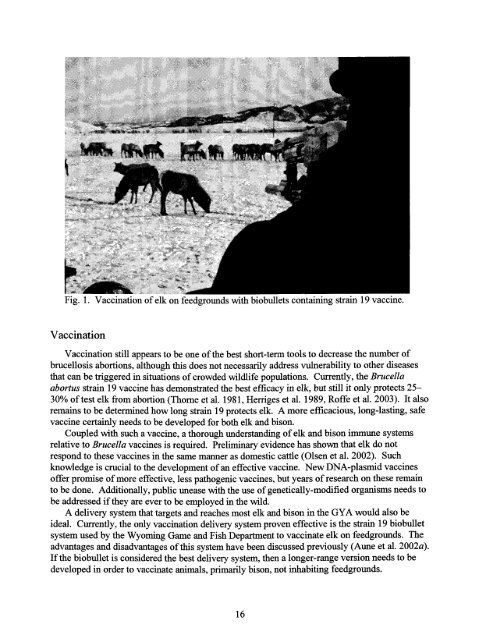brucellosis in elk in the greater yellowstone area - Mule Deer ...
brucellosis in elk in the greater yellowstone area - Mule Deer ...
brucellosis in elk in the greater yellowstone area - Mule Deer ...
You also want an ePaper? Increase the reach of your titles
YUMPU automatically turns print PDFs into web optimized ePapers that Google loves.
Fig. 1. Vacc<strong>in</strong>ation of <strong>elk</strong> on feedgrounds with biobullets conta<strong>in</strong><strong>in</strong>g stra<strong>in</strong> 19 vacc<strong>in</strong>e.<br />
Vacc<strong>in</strong>ation<br />
Vacc<strong>in</strong>ation still appears to be one of <strong>the</strong> best short-term tools to decrease <strong>the</strong> number of<br />
<strong>brucellosis</strong> abortions, although this does not necessarily address vulnerability to o<strong>the</strong>r diseases<br />
that can be triggered <strong>in</strong> situations of crowded wildlife populations. Currently, <strong>the</strong> Brucella<br />
abortus stra<strong>in</strong> 19 vacc<strong>in</strong>e has demonstrated <strong>the</strong> best efficacy <strong>in</strong> <strong>elk</strong>, but still it only protects 25-<br />
30% of test <strong>elk</strong> fiom abortion (Thorne et al. 1981, Herriges et al. 1989, Roffe et al. 2003). It also<br />
rema<strong>in</strong>s to be determ<strong>in</strong>ed how long stra<strong>in</strong> 19 protects <strong>elk</strong>. A more efficacious, long-last<strong>in</strong>g, safe<br />
vacc<strong>in</strong>e certa<strong>in</strong>ly needs to be developed for both <strong>elk</strong> and bison.<br />
Coupled with such a vacc<strong>in</strong>e, a thorough understand<strong>in</strong>g of <strong>elk</strong> and bison immune systems<br />
relative to Brucella vacc<strong>in</strong>es is required. Prelim<strong>in</strong>ary evidence has shown that <strong>elk</strong> do not<br />
respond to <strong>the</strong>se vacc<strong>in</strong>es <strong>in</strong> <strong>the</strong> same manner as domestic cattle (Olsen et al. 2002). Such<br />
knowledge is crucial to <strong>the</strong> development of an effective vacc<strong>in</strong>e. New DNA-plasmid vacc<strong>in</strong>es<br />
offer promise of more effective, less pathogenic vacc<strong>in</strong>es, but years of research on <strong>the</strong>se rema<strong>in</strong><br />
to be done. Additionally, public unease with <strong>the</strong> use of genetically-modified organisms needs to<br />
be addressed if <strong>the</strong>y are ever to be employed <strong>in</strong> <strong>the</strong> wild.<br />
A delivery system that targets and reaches most <strong>elk</strong> and bison <strong>in</strong> <strong>the</strong> GYA would also be<br />
ideal. Currently, <strong>the</strong> only vacc<strong>in</strong>ation delivery system proven effective is <strong>the</strong> stra<strong>in</strong> 19 biobullet<br />
system used by <strong>the</strong> Wyom<strong>in</strong>g Game and Fish Department to vacc<strong>in</strong>ate <strong>elk</strong> on feedgrounds. The<br />
advantages and disadvantages of this system have been discussed previously (Aune et al. 2002a).<br />
If <strong>the</strong> biobullet is considered <strong>the</strong> best delivery system, <strong>the</strong>n a longer-range version needs to be<br />
developed <strong>in</strong> order to vacc<strong>in</strong>ate animals, primarily bison, not <strong>in</strong>habit<strong>in</strong>g feedgrounds.


